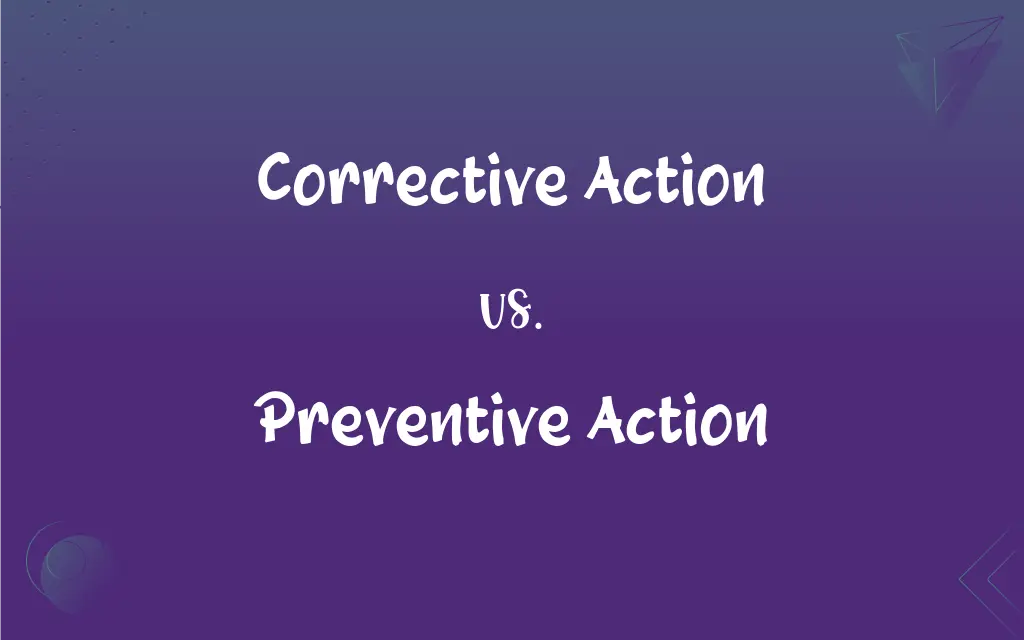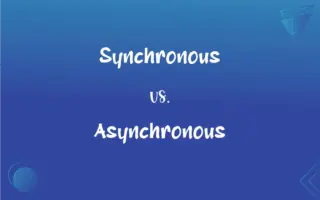Corrective Action vs. Preventive Action: What's the Difference?
By Janet White || Published on November 21, 2023
Corrective action addresses existing problems to rectify them, while preventive action is taken to avoid potential future problems.

Key Differences
Corrective action involves steps taken to fix an identified problem or defect. It is a reactive process, initiated after an issue has occurred, with the aim of preventing recurrence. For instance, repairing a faulty machine is a corrective action. Preventive action, on the other hand, is proactive, taken to prevent a potential issue from occurring. It involves identifying and mitigating risks before they lead to problems, such as regularly maintaining equipment to avoid future malfunctions.
In corrective action, the focus is on understanding the root cause of an issue and implementing solutions to address it. This process often involves analysis and modification of processes or systems. An example of corrective action is retraining employees after a procedural error. Preventive action involves forecasting potential issues and putting measures in place to avoid them. This could include implementing new training programs to ensure employees are well-informed about procedures.
Corrective actions are typically specific and targeted, addressing particular problems that have already manifested. These actions are essential for continuous improvement in quality management systems. Conversely, preventive actions are generally more about strategic planning and long-term improvements, aiming to create systems and processes that inherently reduce the risk of future issues.
The effectiveness of corrective action is measured by the resolution of the existing problem and how well it prevents recurrence. This might involve changes in operational procedures or policies. In contrast, the success of preventive action is gauged by its ability to foresee and mitigate risks, thereby reducing the likelihood of issues arising in the first place, such as updating software regularly to prevent security breaches.
Corrective action is often a response to customer complaints, audits, or identified nonconformities in processes. It is crucial in maintaining current quality standards. Preventive action, while also important in quality management, focuses on future-proofing operations and enhancing overall operational efficiency and effectiveness, often driven by strategic analysis and foresight.
ADVERTISEMENT
Comparison Chart
Nature
Reactive to existing issues
Proactive to prevent future issues
Focus
Addressing and fixing specific problems
Identifying and mitigating potential risks
Trigger
Occurs after an issue is identified
Initiated by risk assessment and foresight
Outcome
Resolution of current problems
Reduction in the likelihood of future problems
Examples
Repairing a broken tool, retraining after errors
Regular maintenance, proactive policy changes
ADVERTISEMENT
Corrective Action and Preventive Action Definitions
Corrective Action
Steps to eliminate the causes of an identified issue.
The corrective action for the data breach included enhancing the firewall.
Preventive Action
Proactive process to eliminate causes of potential future issues.
Implementing a more robust data backup system was a preventive action.
Corrective Action
Reactive process to prevent recurrence of a problem.
After the accident, corrective action involved revising safety protocols.
Preventive Action
Actions taken to prevent potential future issues.
Regular equipment checks are a preventive action to avoid malfunctions.
Corrective Action
Remedial actions to address a known deficiency.
Corrective action was taken to address customer service complaints.
Preventive Action
Preemptive actions to maintain and enhance quality standards.
Changing to a more reliable supplier was a preventive action to ensure quality.
Corrective Action
Measures to rectify a defect or nonconformity.
The corrective action for the production error was to recalibrate the machinery.
Preventive Action
Measures to avert possible defects or nonconformities.
Upgrading the security system was a preventive action against hacking.
Corrective Action
Actions taken to fix a specific existing problem.
Implementing a new software patch was a corrective action against the system crash.
Preventive Action
Steps to mitigate risks before they lead to problems.
Employee training in new regulations is a preventive action for compliance.
FAQs
What is preventive action?
Preventive action is a proactive approach to avoid potential future issues or risks.
What triggers preventive action?
Preventive action is triggered by risk assessments and foresight to prevent future issues.
How do corrective actions improve quality?
Corrective actions improve quality by directly addressing and resolving known defects.
What is corrective action?
Corrective action is a reactive process to fix an existing problem or nonconformity.
When is corrective action necessary?
Corrective action is necessary when a specific problem or error is identified.
Can corrective actions prevent future issues?
Yes, corrective actions aim to fix current issues and prevent their recurrence.
Is documentation important in corrective action?
Yes, documenting corrective actions is crucial for tracking issues and ensuring effective resolution.
Do preventive actions involve updating procedures?
Preventive actions often involve updating procedures or protocols to prevent future risks.
How do preventive actions contribute to quality management?
Preventive actions enhance quality management by reducing the likelihood of future nonconformities.
Are preventive actions based on actual problems?
Preventive actions are not based on actual problems but on potential risks and foresight.
How is success measured in corrective action?
Success in corrective action is measured by the effective resolution of the existing problem.
How important is risk assessment in preventive action?
Risk assessment is critical in preventive action for identifying and mitigating potential issues.
Should preventive actions be documented?
Yes, documenting preventive actions is important for risk management and continuous improvement.
Can preventive actions be part of strategic planning?
Yes, preventive actions are often integral to strategic planning and risk management.
Is employee training a form of corrective action?
Employee training can be a corrective action if it addresses a specific deficiency or error.
How is success measured in preventive action?
Success in preventive action is measured by the effectiveness in reducing future risk occurrences.
What role does analysis play in corrective action?
Analysis plays a key role in identifying the root cause of problems in corrective action.
Can technology upgrades be considered preventive action?
Yes, technology upgrades can be a preventive action to avoid future technical issues or security breaches.
Can corrective action involve policy changes?
Yes, corrective action can involve policy changes if they are needed to fix the issue.
Are corrective actions always a response to complaints?
Corrective actions are often responses to complaints but can also arise from audits or inspections.
About Author
Written by
Janet WhiteJanet White has been an esteemed writer and blogger for Difference Wiki. Holding a Master's degree in Science and Medical Journalism from the prestigious Boston University, she has consistently demonstrated her expertise and passion for her field. When she's not immersed in her work, Janet relishes her time exercising, delving into a good book, and cherishing moments with friends and family.








































































